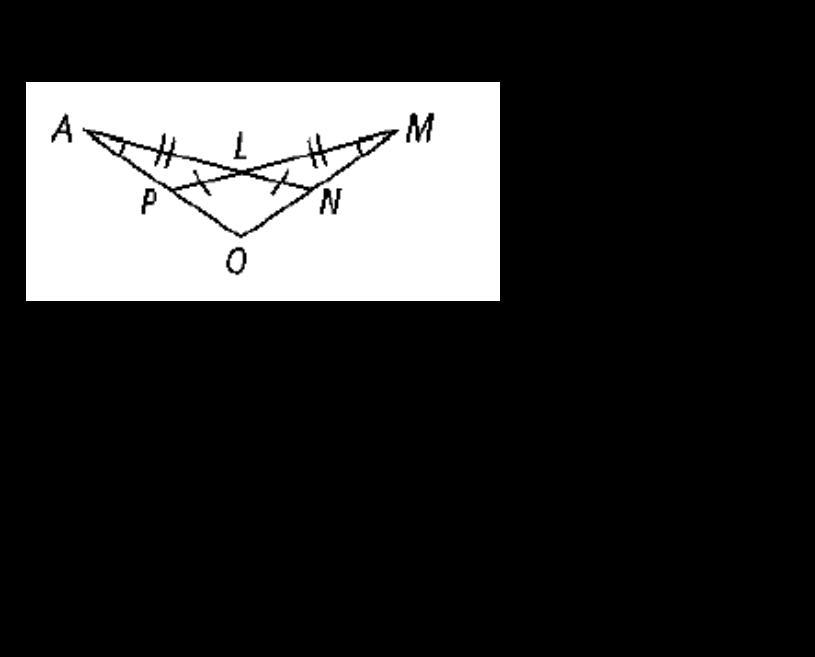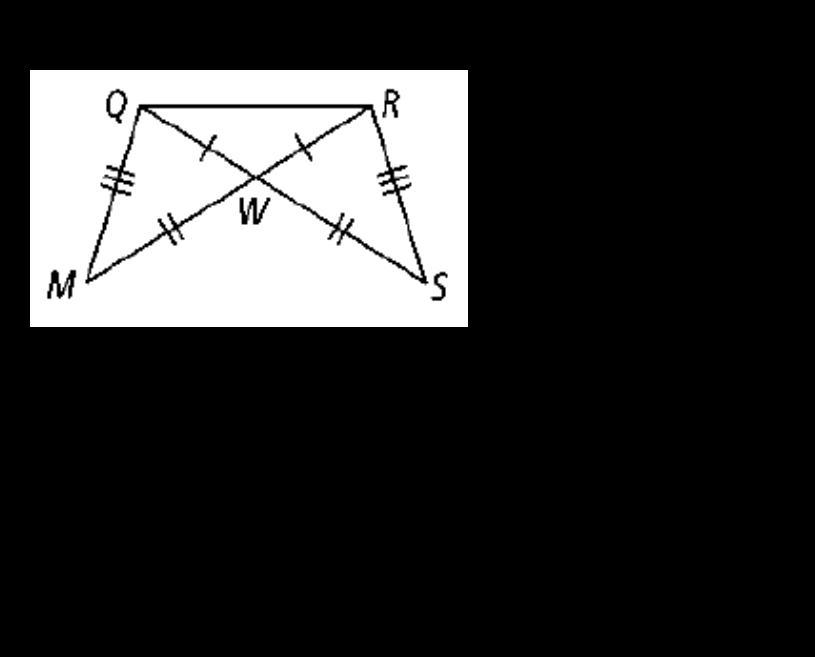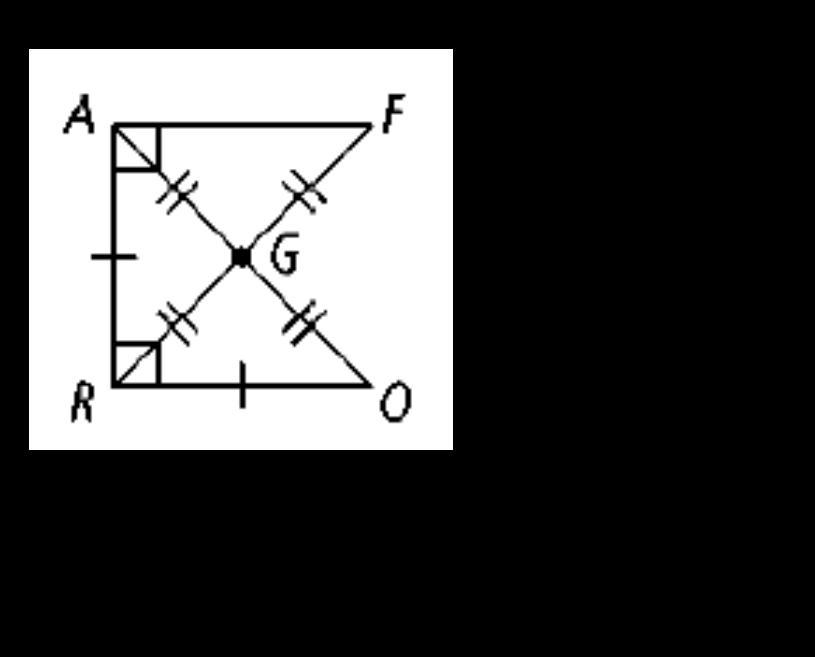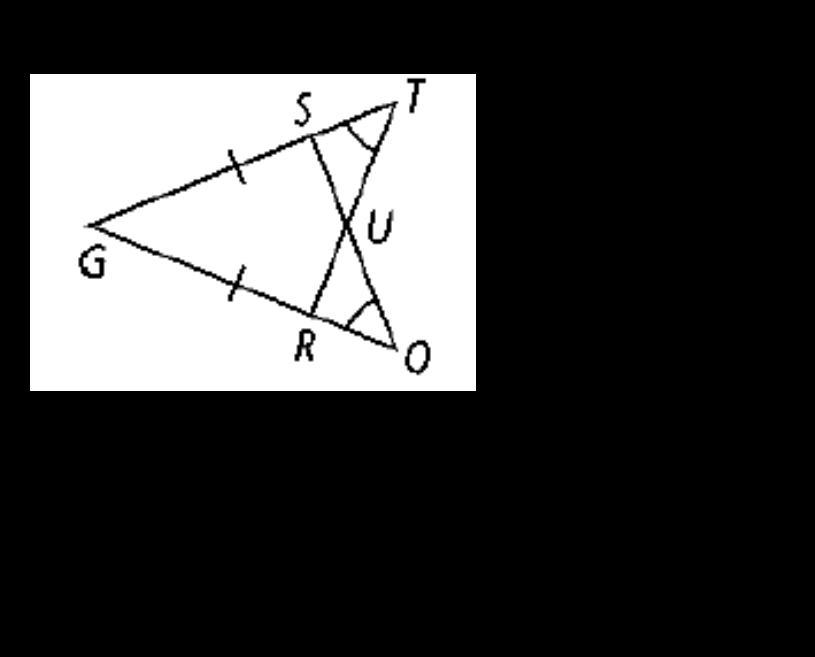Highlight and name a pair of overlapping congruent triangles in each diagram. State whether the triangles are congruent by SSS, SAS, ASA, AAS, or HL.




Answers
Step-by-step explanation:
Diagram 1
ΔALP ≅ ΔMLN by ASAΔANO ≅ ΔMPO by AAS (angle O is common)Diagram 2
ΔMQW ≅ ΔSRW by SSSΔMQR ≅ ΔSQR by SSS (QR is common side)Diagram 3
ΔAGR ≅ ΔOGR by SSSΔARO ≅ ΔARF by HLDiagram 4
ΔGOS ≅ ΔGTR by ASA (∠G is common)ΔSTU ≅ ROU by AAS (∠U is congruent as vertical and RO = ST)Related Questions
Graph the equation.
Answers
I need help on these two PLEASE!!
Answers
Answer:
22.
x=35
y=8
23.
x=30
y=50
Step-by-step explanation:
Write the equation of the line in fully simplified slope-intercept form
Answers
Answer:
y=3x-1
Step-by-step explanation:
Use slope intercept form (y=mx+b) to plug in the values for m and b
the question next to the graph!
Answers
Answer:
Yes there is a proportionality between the amount of money she arns and the hours she works. For every 2 hours she works she earns 30 dollars. Which means she makes 15 dollars an hour.
Step-by-step explanation:
Which sequence shows the numbers in order from least to
greatest?
OA) -2.45 x 102, 193, 6.987
OB) 6.987, -2.45 x 102, 793
OC) V93, 6.987, -2.45 x 102
OD) -2.45 x 102, 6.987, 793
Answers
Answer:
D
Step-by-step explanation:
Just did it
Which statement is true about the prime polynomial 2x2 + 3x + 3?
It cannot be modeled with a rectangle.
It can be modeled with a square.
It cannot be modeled with all positive tiles.
It can only be modeled with an odd number of tiles.
Answers
Answer:
it cannot be modeled with a rectangle
Step-by-step explanation:
let's eliminate the wrong answers first
1. it cannot be modeled with all positive tiles --- this incorrect because it is all positive, so it CAN be modeled with all positive tiles
2. it can only be modeled with an odd number of tiles -- not true, because 2x^2 is even number of tiles
3. it can be modeled with a square -- to be modeled as a square, the polynomial have to be factored into square ie (x+2)², but cann't be factored as square, so again not true
therefore, first one is the answer. because you cannot factor the polynomial as such (x+2)(x+3), so it cannot be modeled with a rectangle.
Answer:
A: It cannot be modeled with a rectangle.
Step-by-step explanation:
100%
help me please.........
Answers
Answer:
the answer is 10,700 :)
Step-by-step explanation:
If angles are supplementary, then one of the angles is an obtuse angle. Answers are these Sometimes always or never pick one
Answers
find the slope and y intercept.
Answers
Answer:
the slope is 2
the y intercept is (-4,0)
Step-by-step explanation:
slope is calcuated by rise over run
Y intercept is (-4,0)
Rise over run
A function is described by the equation
f(x) = 3x – 4. If f(x) = 26, what is the
value of x?
Answers
I need help with this ASAP It will give you 55 points!!!!!!!
Answers
-f * 3/2 = -1/3
-3/2f= -1/3
F= 2/9
what is the answer for
Determine the constant of proportionality for the graph.
10 1/5 5 or 2
Answers
Answer:
1/5
Step-by-step explanation:
y = kx
k is the constant of proportionality
Pick any of the indicated points.
Using point (20, 4)
4 = k(20)
Divide both sides by 20
4/20 = k
reduce
1/5 = k
Hi again could you help me please
Find the area of the composite shape.
Answers
Answer:
For the one on the far left its 104 m2
Step-by-step explanation:
u split the shape in a square and rectangle
them u fin the area of the square by multiplying both sides. (8*8)
then u find the area of the rectangle by using the formula
2*(16+4)
when u find both areas u count them up and it'll become 104 m squared
Solve for the value of m
Answers
Answer:
m=37
Step-by-step explanation:
180-35=145
4m-3=145
4m=148
m=37
Does anyone want to play prodigy with me? if so meet at Town Square in Lamplight Town in Sapphire World. I'm Serenity Nearshadow in that game. PLEASE!
Answers
Answer:
why did you need to play with you are you board of playing then stop playing game
You have 2\3 of a pizza left from yesterday. You divide it into 4 equal pieces. What fraction of the pizza is each piece?
Answers
Step-by-step explanation:
that means we divide 2/3 by 4.
2/3 / 4 = 2/3 / 4/1 = 2/3 × 1/4 = 2/12 = 1/6
so each quarter of the remaining 2/3 pizza is actually 1/6 of the complete pizza.
y=-6/5x +4
y-= -1/5x -1
Answers
Answer: (5,-2)
Step-by-step explanation:
I'm assuming the equations are:
Y=-(6/5)x +4
y = -(1/5)x -1 [Note that I changed "y-" to just "y."]
We can solve this in one of two ways: Mathematically and Graphically.
Math:
y = -(1/5)x -1
6y = -(6/5)x -6
-(Y=-(6/5)x +4)
5y = -10
y = -2
y = -(1/5)x -1
-2 = -(1/5)x -1
-1 = -(1/5)x
5 = x
x = 5
The solution is (5,-2)
Graph:
See the attached graph. The lines intersect at (5,-2)
what is the answer??
Answers
Answer:
D) 39
Step-by-step explanation:
There are a couple of steps to this. First, note that you must plug in the given number that replaces x into the right side's x. After you find the answers, you must then subtract both answers to get your result.
First step, find g(8):
g(x) = 3x - 2
When x = 8,
g(8) = 3(8) - 2
Remember to follow PEMDAS, the order of operations. First, multiply, then subtract:
g(8) = (3 * 8) - 2
g(8) = (24) - 2
g(8) = 22
Next step, find g(-5):
g(x) = 3x - 2
g(-5) = 3(-5) - 2
g(-5) = (3 * -5) - 2
g(-5) = (-15) - 2
g(-5) = -17
Note that you are subtracting both numbers. When there are two negative signs directly next to each other, it becomes a positive:
22 - (-17) = 22 + 17 = 39
D) 39 is your answer.
~
What is the constant of proportionality in this
equation?
y= 20x
Answers
Answer:
k=20
Step-by-step explanation:
The constant of proportionality, k, measures the constant value of the ratio between two proportional quantities, being y and x in this case. Essentially, y/x will always equal 20, the constant of proportionality.
the line passes through (-6,9)
perpendicular to y=3x-2
Answers
The key to understand this problem is that perpendicular lines have slopes that are the negative reciprocals of each other. Example, a line with slope 3/4 has a perpendicular with a slope of -4/3. So flip it over and take the negative. Like 7/12 and -12/7 or 2 and -1/2 (because 2 = 2/1)
The slope of y = 3x - 2 is 3 (the number preceding the "x' if the line is in the form y = mx + b)
So the line perpendicular to y = 3x - 2 has a slope of -1/3.
So now you just need to write the equation of the line with slope -1/3 that goes through (-9, 5). Use the point-slope form, y - y1 = m(x - x1) where (x1, y1) is (-9, 5) and m = -1/3
y - 5 = -1/3(x - -9)
y - 5 = -1/3(x + 9)
That's the answer. If they want you to give the answer in the y= mx + b format (slope-intercept) then multiply it out and combine like terms.
y - 5 = -1/3(x + 9)
y - 5 = -1/3x - 3
y = -1/3x + 2
How to add fractions with whole numbers.
Answers
Answer:
To add a fraction to a whole number, convert the whole number into a fraction, form a common denominator, and then add the two numerators.
Step-by-step explanation:
Help me please I’m bad at slopes
Answers
can someone please help me with this
Answers
Answer:
y-intercept =3
x-intercept =3/2
slope =-2
Step-by-step explanation:
y=-2x+3
0=-2x+3
2x=3
x=3/2
Determine if y=3⋅2z+12 is linear, quadratic, or exponential.
Answers
Answer:
Exponential
Step-by-step explanation:
2z
9. Which of the following relations are functions? Choose all that apply. Assume that each different variable
has a different value.
{(a,b),(0,0),(c.c),(e,d)}
{(c,e),(c,d),(0,b)}
{(6,5),(c,d),(d.c),(0,0)}
{(a,b),(b,c),(c,d),(d,e)}
Answers
Answer:
A and c sorry if I'm wrong
Solve the attached problem please
Answers
Answer:
41910.
Step-by-step explanation:
We can calculate this by first finding the sum for k = 1 to 50 then subtracting the sum for k = 1 to 14.
We use the formula (1/6)n(n+1)(2n+1)
So for 1 to 50 its 1/6 * 50* 51 * 101 = 42925
and for 1 to 14 it comes to 1/6*14*15*29 = 1015
So the answer is 41910.
What is an equation of the line that passes through the points (6,-3) and (-6,-5)
Answers
Answer:
y = 6x - 4
Step-by-step explanation:
I drew a graph slope formula is (y2 - y1)/(x2 - x1) and if the line passes through a point that is not zero (in this case it does) we add or subtract that as the y-intercept. we recently passed this so I know it.
Slope-intercept form: (y = mx + b) y = 6x - 4
Standard form: (Ax + By = C) -6x + y = -4
Point-slope form: (y - y1 = m (x - x1)) (let's use the point (6, -3)) y + 3 = 6 (x - 6)
Tell me if I'm wrong :)
Answer:
Step-by-step explanation:
Bu using the formula of Two-Points form:
[tex]\frac{y-y_{1} }{y_{2}-y_{1} } =\frac{x-x_{1} }{x_{2}-x_{1} }[/tex]
Substitute the points in the above equation:
y+3/-5+3=x-6/-6-6
y+3/-2=x-6/-12
-12(y+3)=-2(x-6)
-12y-24=-2x+6
2x-12y-24-6=0
2x-12y-30=0
Or
x-6y-15=0
If you need to ask any question,let me know.
The sides forming the right angles and hypotenuse of a right angled triangle are x cm, (2x + 2) cm and (3x – 2) cm respectively. Calculate the perimeter of the triangle.
Answers
Answer:
6x
Step-by-step explanation:
Perimeter is the sum of all the sides:
(x) + (2x + 2) + (3x - 2)
Add like-terms:
6x + 2 - 2 = 6x
Perimeter = 6x
polynomials functions please help
Answers
Answer:
Step-by-step explanation:
Polynomial Functions. A polynomial function is a function that involves only non-negative integer powers or only positive integer exponents of a variable in an equation like the quadratic equation, cubic equation, etc. For example, 2x+5 is a polynomial that has exponent equal to 1.
What kind of sequence?
8,4,2,1....
A geometric
B arithmetic
C neither
Answers
Answer:
A. geometric
Step-by-step explanation:
The rule is to divide by 2: if you are dividing or multiplying between each term, then the sequence is geometric.
Arithmetic sequences add or subtract the same number between each term.
Hope this helps.